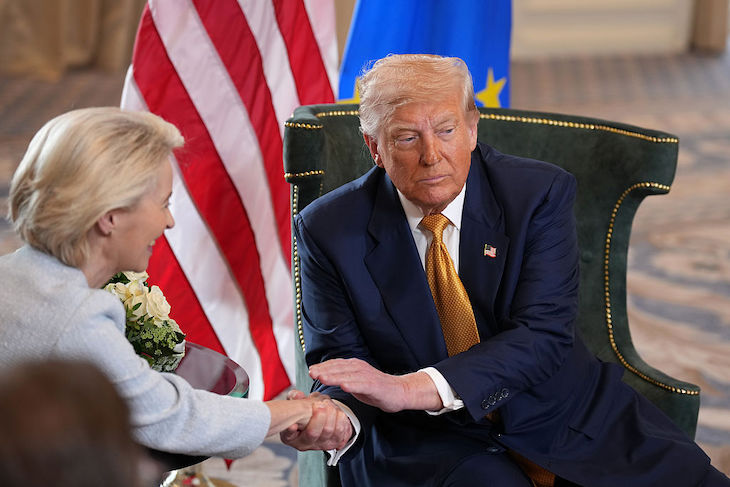The US-EU trade deal has been given a lukewarm reception in Europe. Although the agreement between US president Donald Trump and the president of the European Commission Ursula von der Leyen is merely a framework, rather than a full-trade deal, there are already major concerns on the continent, especially in Germany – a country famously reliant on exports.
German chancellor Friedrich Merz did not seem too pleased with the deal, negotiated by his party colleague von der Leyen. ‘I’m not satisfied with the result in the sense that (it was said) this is good as it is,’ Merz stated. ‘Which, in plain terms, means the German economy will suffer significant damage.’
Europe could pay a big price for its weakness in dealing with Trump
Trump certainly seems to be the big winner from the deal which was thrashed out during the president’s trip to Scotland. The EU has agreed to purchase £558 billion in US energy, and will also up overall investment in the US by £459 billion.
‘We will replace Russian gas and oil with significant purchases of US LNG, oil and nuclear fuels,’ said von der Leyen. No wonder Trump was smiling. Jens Südekum, an advisor to Germany’s finance minister Lars Klingbeil, suggested the agreements on energy would strengthen the American, rather than the German, economy. It’s clear to see why.
The response from industry representatives, especially those speaking for German car manufacturers or the national steel and aluminium industry, was even more downbeat. Importers bringing EU cars to the US face tariffs of 15 per cent. Even though the rate of 27.5 per cent imposed by Trump in April has nearly been halved, the consequences for the likes of Volkswagen and BMW are likely to be severe.
German car manufacturers must surely now increase prices in order to balance the books. The prospect of being effectively forced into moving production from Europe to the United States is also looming. Volkswagen stated that it will decide whether it ought to expand its engagement in the US market once the final agreement is on the table. Meanwhile, VDA, the German car manufacturers trade organisation, predicts that a rate of 15 per cent could ‘cost the German automotive industry billions annually.’
The steel industry has voiced similar concerns, even though the specific rates for exports into the US are yet to be determined. ‘As long as steel tariffs are enforced at a rate of 50 per cent, the consequences for exports from Germany and the EU towards the USA are dramatic,’ said Kerstin Maria Rippel from WV Stahl, the trade association for Germany’s steel industry.
When the agreement – billed as the largest trade deal in history – was announced on Sunday, there was some optimism that further escalation between Europe and the United States had been avoided. However, after the dust settled, the verdict is less optimistic. French prime minister, François Bayrou, labelled the framework deal a ‘dark day’ for the EU. Industry leaders soon pointed out the damage that Germany, but also the EU, is now facing. ‘Who is awaiting a hurricane, is thankful for a thunderstorm,’ Wolfgang Große Entrup, representative of the trade association of Germany’s chemical industry, concluded. Is a bad deal better than no deal? Germany, and the rest of the Europe, is about to find out.
It is true that the US would have likely imposed a general tariff of 30 per cent on the first day of August, had Trump and von der Leyen not announced a first agreement in Turnberry. But this doesn’t mean the EU has won: the outline of the anticipated deal leads to the conclusion that the US has triumphed at the negotiating table. Europe could pay a big price for its weakness in dealing with Trump.







Comments